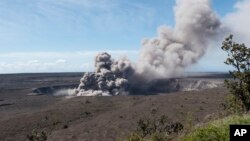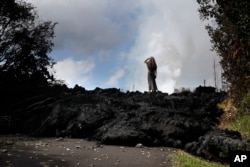The eastern point of Hawaii's Big Island continued to experience temblors from the Kilauea volcano Saturday as local officials urged residents of lower Puna district to be prepared to evacuate on short notice.
The U.S. Geological Survey recorded more than two dozen earthquakes in the area near the east coast of the Big Island on Saturday alone. Most were magnitude 2 and 3, not strong enough to cause damage.
USGS scientist Tina Neal at the Hawaiian Volcano Observatory has been posting regular video updates. In her latest report, she said volcanic activity was still high.
"The situation remains unstable," she said. "Additional outbreaks of lava are likely." She said the lava inside the volcano sank out of site, replaced with steam plumes rising into the sky.
But experts said there was a continuing threat that the lava could drop below the water table. If that happens, water could pour onto the hot lava and produce enough steam to explode from the summit in a shower of ash and debris. Rocks "the size of cows" could be hurled as far as 800 meters from the site of the blast, according to one expert who spoke to local media.
The subdivisions of Leilani Estates and Lanipuna Gardens are under mandatory evacuations, with residents describing fissures in the streets emitting steam or lava.
On Friday, U.S. President Donald Trump declared the volcano-affected area a major disaster area, making federal funds available to help state and local governments cope with the eruption and its aftermath. The volcano began erupting May 3.
More than a dozen fissures have already opened in the ground near the volcano, releasing lava that has destroyed at least 27 homes. About 2,000 people have been evacuated. Hundreds of households are without power, with as many as 50 utility poles damaged by lava.
Authorities said they had removed flammable liquids from a geothermal plant in the area to prevent possible explosions there. Residents and officials remained concerned about potential explosions and toxic gas leaks from the plant's underground wells, which provide heat for electricity production.
Hawaii experienced a magnitude 6.9 earthquake on May 5 near the southern part of the volcano, the island's largest tremor in more than 40 years.
Officials have warned about high levels of sulfur gas in the air that could threaten the elderly and people with breathing problems.
The Kilauea volcano has been erupting periodically for more than three decades. Lava flows from the volcano, one of five on the island, have buried an area about 125 square kilometers, according to the USGS.
Scientists said they could not predict how long the current eruption would last.










